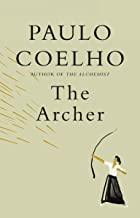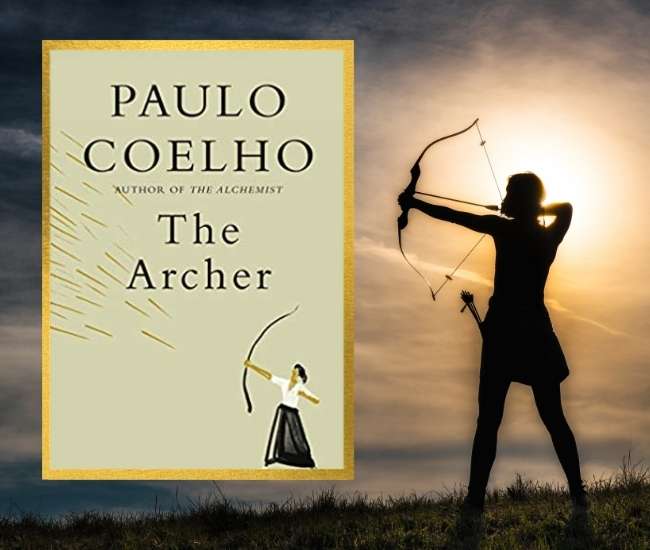The Archer by Paulo Coelho
Paulo Coelho has produced some twenty books in his lifetime, including bestselling masterpieces such as The Alchemist. Now in his 70s, he is perhaps Brazil’s most celebrated contemporary author. His most recent book, The Archer (Knopf), translated from the Portuguese by Margaret Jull Costa, is inspiring as ever.
The story features Tetsuya, a carpenter in a small village. One day, a young stranger from far away arrives in search of him. The stranger reveals that the carpenter is the country’s finest, most legendary archer. He then challenges Tetsuya to a competition, hoping to capture that title. With quiet confidence, Tetsuya agrees. After the competition and the departure of the stranger, Tetsuya answers questions posed by a boy who has witnessed the experience. He also shares why he has kept his skill a secret.
This minimalist narrative is split between a prologue and an epilogue, thus framing a series of thirteen eloquent lessons. The chapters, ranging from a few lines to several pages, detail the proper gestures a novice archer must learn in order to excel. They explore the relationships among the archer and his bow, arrow and target, as well as who should accompany the novice along his journey toward mastering the craft. Coelho recounts these lessons from the point of view of the mentor, lending to the story the mood of a timeless parable or fable. His language evokes poetry more than step-by-step instructions.
EXPERT SYMBOLISM IN THE ARCHER
Such simplicity in storytelling disguises a more complex message than how best to pull back a bowstring; it fosters an understanding of the higher self and a reverence for life’s many stages. Like the tenets of Taoism, the story demonstrates the fulfillment that comes from relentless practice and mindful intention. The narrator likewise emphasizes the wisdom the student may gain from all experiences, even so-called failures. Awareness of negative feelings can lead to a student’s growth instead of thwart it. The author’s closing acknowledgements refer to spirituality and Japanese Zen interpretations of archery underlying the book’s many messages.
Coelho goes so far as to redefine terms such as “master” or “target,” explaining that one cannot exist without the other. “Just as the arrow seeks the target, so the target also seeks the arrow, because it is the arrow that gives meaning to its existence.” Such philosophical nuggets provoke reflection long after the reader has closed the book.
THE ARTISTIC DETAILS
Adding to Coelho’s lyricism, the streamlined paintings by award-winning illustrator Christoph Niemann set a tone of symbolic elegance, making the book ideal in print rather than e-book. Like each gesture the archer makes, Niemann’s illustrations embody the book’s theme in graceful symbols.
Coelho’s keen understanding of humanity’s yearning for enlightenment emerges again and again in his work. “Enlightenment” does not conform to the Western notion of happiness in the sense of “fun” or even “love” but is a quieter experience related to discovering one’s soul. In Alan Riding’s New York Times article from August 2005, “Paulo Coelho: Writing in a Global Language,” the prolific author says, “What surprises me is when I’m called a spiritual writer. For me, the pursuit of happiness is a lie, as if there were a point when everything changes, when you become wise. I believe enlightenment or revelation comes in daily life. I look for joy, the peace of action.” This relationship between the self and physical activity is quintessential to Coelho’s ethos and writing. For fans of Zen philosophy and metaphysical fiction, The Archer is a must-read.





What a delight to receive Paulo’s latest bestseller this week – it is a wonderful book for several reasons. I was in the team at HarperCollins that published The Alchemist and the first to predict it would be a global bestseller! Also Paulo’s new book is a beautiful keepsake volume with inspiring illustrations by award-winning illustrator Christoph Niemann that are in perfect harmony with the subject of this book: inspirational meditations on Zen and the art of archery.
Zen Buddhism can, for those of us growing up in the west, be very difficult to grasp in it’s multiple paradoxes, but this book eases the reader into the very essence of the philosophy through the analogy of archery. As Paulo says in his blog, ‘It is a short book, you don’t need to complicate things. In fact, life is simple. We complicate a lot. And a fable or allegory talks to the hidden parts of ourselves.’
Why did Paulo choose the art of archery as the analogy to reveal the life-art of Zen? Besides being a weapon of war, in many ancient texts on Buddhism, listed among the sacred implements is the bow and arrow. The premise is simple; by understanding the art of archery, we can learn the art of Zen – which is the art of life. In addition to this, archery is Paulo’s favourite sports pastime, so he has a knowledge of the intricacies of the skills needed.
What can we learn from archery about Zen and the art of life? Through his poetic and soulful thoughts. Paulo offers insights into a number of key lessons from Zen:
Know and respect your allies in the contest, while learning from their successes and failures.
The bow is your greatest asset and is the source of your energy.
Your intention is within the arrow.
The object of your focus is the target.
How you execute a successful shot – from your posture, through letting fly the arrow, to hitting the target – is the same as the skills you need in life.
The Archer will not leave my bedside and my guess is over many years, I will subliminally commit most of the wisdom it imparts to memory. Even if I never become a full time student of Zen Buddhism, I will at least have learned to adopt it’s most essential life enriching lessons by making this book my daily companion.
Thank you Paulo!
What a delight to receive Paulo’s latest bestseller this week – it is a wonderful book for several reasons. I was in the team at HarperCollins that published The Alchemist and the first to predict it would be a global bestseller! Also Paulo’s new book is a beautiful keepsake volume with inspiring illustrations by award-winning illustrator Christoph Niemann that are in perfect harmony with the subject of this book: inspirational meditations on Zen and the art of archery.
Zen Buddhism can, for those of us growing up in the west, be very difficult to grasp in it’s multiple paradoxes, but this book eases the reader into the very essence of the philosophy through the analogy of archery. As Paulo says in his blog, ‘It is a short book, you don’t need to complicate things. In fact, life is simple. We complicate a lot. And a fable or allegory talks to the hidden parts of ourselves.’
Why did Paulo choose the art of archery as the analogy to reveal the life-art of Zen? Besides being a weapon of war, in many ancient texts on Buddhism, listed among the sacred implements is the bow and arrow. The premise is simple; by understanding the art of archery, we can learn the art of Zen – which is the art of life. In addition to this, archery is Paulo’s favourite sports pastime, so he has a knowledge of the intricacies of the skills needed.
What can we learn from archery about Zen and the art of life? Through his poetic and soulful thoughts. Paulo offers insights into a number of key lessons from Zen:
Know and respect your allies in the contest, while learning from their successes and failures.
The bow is your greatest asset and is the source of your energy.
Your intention is within the arrow.
The object of your focus is the target.
How you execute a successful shot – from your posture, through letting fly the arrow, to hitting the target – is the same as the skills you need in life.
The Archer will not leave my bedside and my guess is over many years, I will subliminally commit most of the wisdom it imparts to memory. Even if I never become a full time student of Zen Buddhism, I will at least have learned to adopt it’s most essential life enriching lessons by making this book my daily companion.
Thank you Paulo!